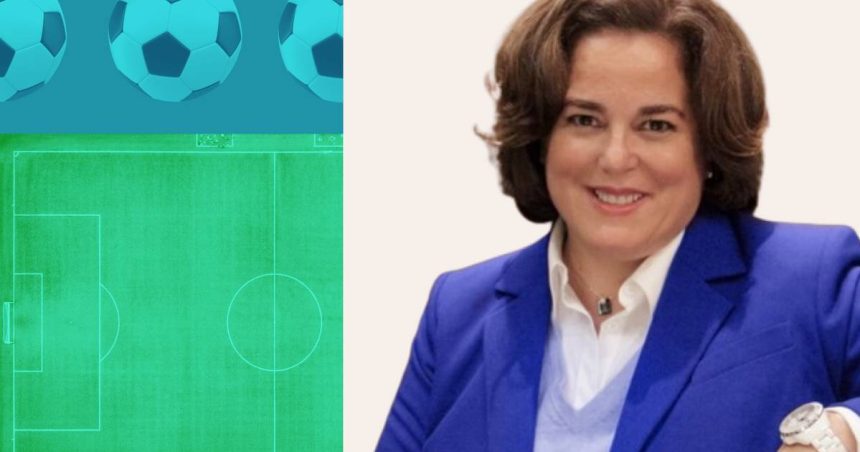This story is the latest in our series on women leaders in sports and sports marketing. Read the rest of the profiles here.
In a conference room at the headquarters of the National Women’s Soccer League on Madison Avenue one afternoon in late October, Julie Haddon, the league’s chief marketing and commercial officer, had just sat down for an interview when she had an idea for this weekend’s championship festivities. It couldn’t wait.
“Watch me work for one second,” she said, picking up her phone to make a call.
For Haddon, turning off-the-cuff ideas into reality is par for the course. She didn’t land marketing leadership roles at companies including PayPal, Twitter, eBay, SoFi, and the NFL without a little multitasking—as well as a lot of passion and some heavy lifting to boot.
She joined the NWSL as CMO in 2022, and in the two years since, the league expanded from 12 to 14 teams (with moreset to join for the 2025 season), signed a four-year media rights deal worth a reported $240 million (its previous three-year deal was worth $4.5 million), and has seen regular-season attendance climb from just over 1 million to 2 million.
It’s a far cry from when Haddon watched her first live women’s soccer game at the 2019 FIFA Women’s World Cup, when fans, merchandise, and hype seemed scarce, and the women’s sports landscape looked much different than it does today.
“There was no depth, there was no breath, there was no accessibility to find [women’s soccer],” Haddon told Marketing Brew. “It was hard to experience like a fan…and I got obsessed with fixing that.”
Wake-up call
When Haddon was SVP of global brand and consumer marketing for the NFL in 2019, she attended a Women’s World Cup game at Allianz Riviera stadium in Nice, France, around the time of Cannes Lions, she said. While it was women’s soccer at the highest level, Haddon said she was surprised to see plenty of empty seats and the absence of merch for sale.
It was something of a turning point for Haddon, who acknowledged she didn’t even know there was a league where so many of the USWNT’s stars played in the states. A week later, she made a promise to herself to “make the world a better place for women through sport,” she said, writing down the pledge in a notebook that she has to this day.
In 2021, she got directly involved, becoming an owner of the Chicago Red Stars, though she eventually gave up her stake in the team to join the league’s front office the next year. There, she personally recruited much of the rest of the marketing department.
Haddon still likes to maintain relationships with those recruits, and during last year’s championship weekend in San Diego, she invited every league employee who traveled there for the event to her hotel room for pizza after the game, Director of Marketing and Commercial Operations Caroline Chagares recalled.
“I knew her as this baller businesswoman,” Chagares said. “She has this incredible résumé working at all these different companies—big companies, startup companies—in different roles, but the fact that she put that on after an event that there was so much time put into…really says a lot about her as a leader.”
Up close and personal
One of Haddon’s first projects as CMO was changing the content coming out of the league. At the time, she said, it was largely wide-angle shots from broadcasts of games, as opposed to close-ups or behind-the-scenes moments that many sports marketers have come to realize can help make fans feel more connected to athletes. At the NFL, Haddon called it “helmets off” content, and she wanted to replicate the strategy at the NWSL, she said.
Get marketing news you’ll actually want to read
Marketing Brew informs marketing pros of the latest on brand strategy, social media, and ad tech via our weekday newsletter, virtual events, marketing conferences, and digital guides.
In September 2022, San Diego Wave FC sold out a game against rival Angel City FC, and the 32,000 tickets sold broke an NWSL record at the time. Haddon “wanted the world to see that,” she said, so she hired a videographer and some sideline correspondents to cover the match.
“It probably cost $2,000 all in,” Haddon recalled. “But from that, 15 million people were able to see the game, versus the 32,000 people who were there, or the small audience that might have seen it at the time when we didn’t have a bigger broadcast deal.”
That initiative evolved into “Pitchside with Pixel,” a social-first content series sponsored by Google Pixel as part of its multiyear partnership with the league.
There have been other efforts to introduce the league to new fans. At the start of Haddon’s first full season with the NWSL in 2023, she spearheaded the “We Play Here” campaign, which she said was inspired by her experience at the 2019 World Cup. Not only did it introduce the league to new fans, but it helped boost brand metrics, too.
“She has such a vision,” Chagares said. “She can come up with a creative idea within 10 seconds…She brings these huge ideas to a more growing company, and it really makes us better.”
Marketers have layers
Even before her contributions to the NWSL, Haddon’s list of professional accomplishments was long.
As acting head of marketing and business development at Twitter in the late aughts, she pitched co-founder Jack Dorsey on the idea of the verified badge (and she still has the email as proof). In the late ’90s and early 2000s, she worked at DreamWorks Animation, where she helped market movies like Ants and Shrek. And her first job out of college was for the Los Angeles Dodgers, the closest she got to living out her childhood dream of playing baseball in the major leagues.
But it’s her current work at the NWSL that evoked a smile as she glanced around the league’s office walls, adorned with scarves representing each of the NWSL’s teams.
“I’m proud of how we’ve woven ourselves in culture, how women’s sports has found a moment that is so pervasive,” Haddon said. “I’m very proud of the ability to help shape culture and the conversation…I look around this building and I think, ‘Those scarves are there because of me.’”
Read the full article here










